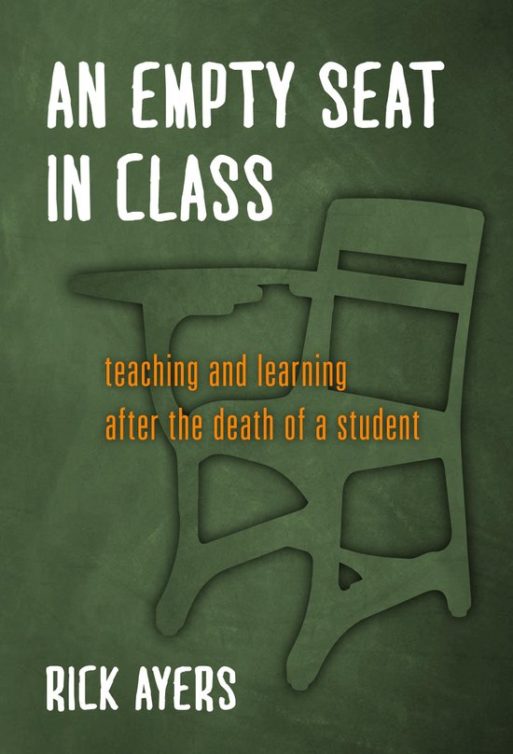 Rick Ayers’ book “An Empty Seat in Class” deals with an issue that many of us probably don’t consider very often: how the death of a student impacts teachers.
Rick Ayers’ book “An Empty Seat in Class” deals with an issue that many of us probably don’t consider very often: how the death of a student impacts teachers.
“An Empty Seat in Class” is comprised of 10 sections, each dealing with a different idea related to coping with the death of a student. In most of the sections, Ayers includes anecdotes and essays written by other teachers who’ve lost a student(s). It is a much more common phenomenon than one would think.
The 10 chapters run the gamut of issues related to student deaths. For instance, there’s a section on wrong ways to deal with the death of a student; a chapter calling on the need to better prepare teachers for student deaths; and a chapter on how schools can better prepare for dealing with student deaths. There is also a chapter that discusses how teachers oftentimes become both mourner and “officiate” of a student’s death. Teachers unfortunately will often suppress their own emotions in an attempt to “be there” for the students left behind. But ultimately, this is extremely unhealthy for the teachers themselves. There’s also a chapter that touches on school shootings, titled “Our Worst Nightmare.”
In the introduction, Ayers describes what the purpose of the book is and is not. “It is not a how-to book because there are no clear answers,” he writes. “Rather, it offers the experiences of teachers to help colleagues and communities find their own way.” He mentions that every single student is a unique person, and that “no one else has ever been or ever will be the same as this person.” It is that fact that makes dealing with the death of a student all the more difficult. There are no “right” or “proper” ways to go about the healing process.
An idea that Ayers revisits time and again in the book is the need to establish a sense of community within the school. He believes this is the most vital tool in dealing with the death of a student. Towards the end of the book, Ayers writes, “The number-one take-home is that you have to build community now to survive the crisis later. You cannot start building community when the crisis strikes.”
Ayers touches on a number of ways that students die, but much of “An Empty Seat in Class” deals with student deaths that are caused by violence. One of the teacher-written anecdotes in particular touches on this subject.
In “Addressing the Issue in the Academy,” Leora Wolf-Prusan, a former teacher who studies the effects of violent student deaths on teachers, talks about how teachers need a certain kind of support after a student has died violently. She writes, “My study voices the need for teachers’ experience of their students’ violent deaths to be recognized, honored, and supported.” She also mentions how violent deaths create a change in teachers’ overall attitudes towards their students. For instance, they become more empathetic and caring, and tend to take on more of a protector role following a violent student death.
“An Empty Seat in Class” is at times difficult to read. The educators’ personal stories included in the book often made me teary-eyed. One teacher’s piece in particular made me cry. Hasmig Minassian writes about her experience in dealing with the death of her student, Kyle. He died in an automobile accident during their school’s spring break. In it, she includes thoughts written by some of her students following Kyle’s death. Many of the students are confused, unsure of how they should feel, scared and fearful that they may not honor their fallen classmate properly. It is just heart-wrenching to read teenagers’ thoughts on the matter of a classmates death. 
Uplift Through the Pain
As sad as much of the book is, I found solace in the fact that the many teachers who contributed to the book care so deeply for their students. These teachers feel so connected to their students that when one dies, it is almost like they have lost a family member. Ayers writes, “…we are not family, yet we have a family-like intimacy with our students. Like parents, we approach students with feelings of unconditional love.” I think parents would find that notion quite soothing, knowing that their children are in such caring hands.
One of the more important takeaways from the book is that our society needs to address the issue of how a student’s death impacts both teachers and the overall school community. Too often, school districts take the stance of “no comment” regarding the death of a student. Schools are where our youth go to learn, to become contributing members of society. Yet, too often we treat schooling as just a means for them to make money later in life.
After reading “An Empty Seat in Class,” it’s clear to me that most teachers view their work as much more than simply preparing students for a wealthier future. They see their students almost as their own kids, and truly want what’s best for them. So they try their best to create a positive community. Our society would be smart to do the same.

 “An Empty Seat in Class,” by Rick Ayers
“An Empty Seat in Class,” by Rick Ayers


 Recovering Cremation Remains After the Los Angeles Fires
Recovering Cremation Remains After the Los Angeles Fires
 “As Tears Go By” by Marianne Faithfull
“As Tears Go By” by Marianne Faithfull















